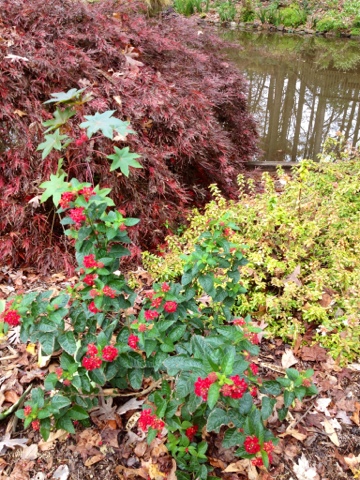For year round interest in gardens in woodlands, look for every detail offered up by the trees and shrubs. The bark of my magnificent trees are doubly enhanced when an interesting branch of a flowering shrub full of next springs buds crosses in front. Above is an almost perfectly horizontal budded branch of 'Shasta' Viburnum in front of an impressive Loblolly Pine. The evergreen behind is Canadian Hemlock.
Two smoothed barked trees with pointed buds from their own branches are: Stewartia monodelpha, left, and native Magnolia tripetala, right.
I grow my gardens under native Dogwood, left, and Loblolly Pine with sprinklings of Sweet Gum trees shown on the right.
Winter flower buds of Mahonia bealei, left, are breaking out in upright yellow clusters of tiny fragrant bells while a dwarf 'Temple Bell' Pieris , right, holds tightly on to decorative buds until early spring. These two shrubs also keep their leaves through the coldest temperatures.
On the left, snowy dots of a Corylopsis shrub add a textural depth to this part of the border along the driveway. On the right is an all time favorite. A show stopping display of twin pairs of silvery satan buds are seemingly adrift on the tips of Edgeworthia 'Cream Ball'. The buds will open in March and flower for a month perfuming the front courtyard.
Did you guess that these are both Tulip Poplars? On the left is our native Liriodendron tulipifera and on the right, from China, Liriodendron chinense. The difference in the bark is striking as are the size and shape of the leaves. I consider them sister trees uniting from around the world. In my garden they grow almost side by side.
I was introduced to this green barked Maple seedling at Camellia Forest Nursery and had to try it. It is flourishing in fairly deep shade on 4.9 pH soil. On the right is the sensuous bark of Magnolia x loebneri 'Merrill'. It is an upright tulip type Magnolia with reliably hardy buds that casts its flowery fragrance 300 yards away.
Showy buds of two other evergreen shrubs are on Winter Honeysuckle, left, where single buds sit in each leaf axil along the stems blooming off and on through the warm spells of winter. The plant on the right is an Agarista, previously known as Leucothoe, showing sprays of buds nestled in the leaf axils and the very tip of arching stems. The buds wait all winter to expand in the spring.
Chunky or flakey bark on two very different trees always catch my eye in winter. On the left is the stately single trunked native Persimmon and on the right, hailing from Europe, is the flaking bark of multi trunked Cornus mas. If you love the bark of a River Birch but haven't the room and want a shorter tree this is one to consider for smaller spaces.
The left hand picture shows our native Red Cedar which is actually a Juniper. The peeling bark is prized by birds for nest making. On the right is a fantastic ornamental shrub/tree that can be pruned and managed as more upright to be able to better appreciate its mystical white exfoliating bark in the winter. Hepticodiym miconoides is hardy from USDA zones 5-8 and is a wonderful pollinator that blooms in late summer. Google: Chicago Botanic Garden and Seven-Son-Flower in the same line for more information on the reintroduction of this unusual plant into our western gardens.
Above is a distant early spring view of Hepticodium on the left and Cornus mas on the right in a south facing border at the edge of the woods.
Finally, the bark of two of my finest trees. On the left, looking for all the world like a giraffe, is Lagerstromea fauriei, the Japanese Crape Myrtle. Standing 25' tall, exfoliating cinnamon bark envelopes the trunk to the uppermost branches. Summer blooms are fragrant white. I love the carpet of tiny falling petals without any messy seed capsules later. You must have lots of room in your garden to grow this tree. On the right see how rough and almost charred looking the trunk of Prunus mume 'Peggy Clark' is.
Above, buds along the stems of Prunus mume 'Peggy Clark' fatten and burst reliably in December with a delicious spicy scent. It will flower for a month and produce a summer fruit that the Japanese love to pickle and eat daily. Thus, it's common name, Japanese Flowering Apricot.



















































